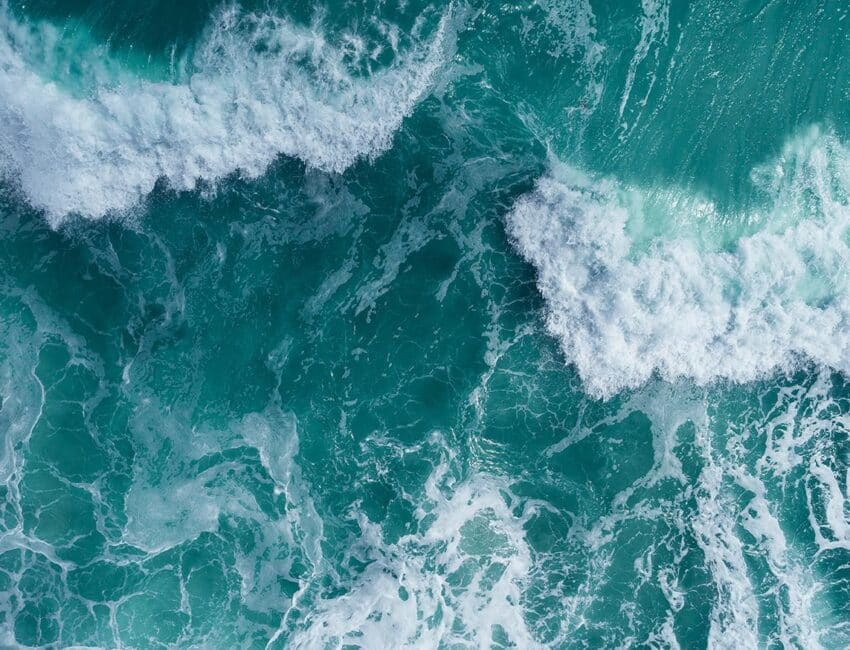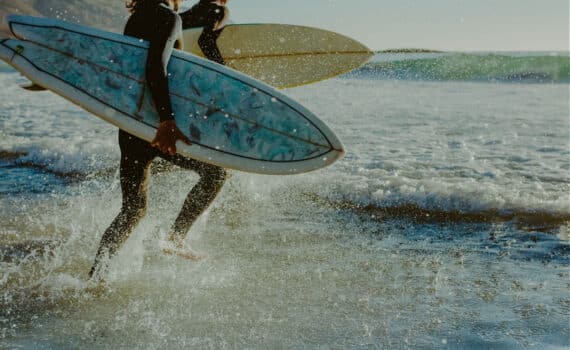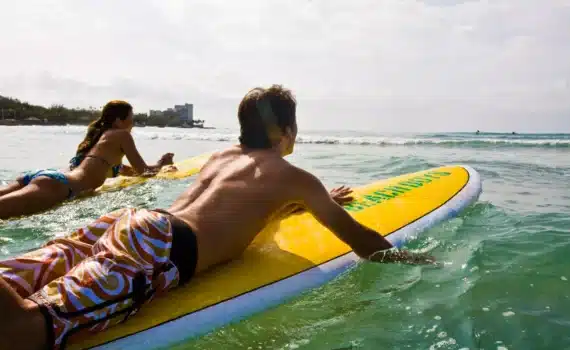Surfers dream of catching that perfect wave—one with ideal height, smooth face, and perfect curl. These magnificent walls of water roll toward the shore, leaving us in awe. The science behind wave formation shows nature’s physics at work, from gentle winds pushing across the ocean to complex interactions with the seafloor. Let’s explore the science of wave formation and find what creates these sought-after perfect waves that turn surfing dreams into reality.
Understanding Wave Formation Mechanics
Let’s take a closer look at the fascinating mechanics behind wave formation. The ocean’s surface shows us a complex dance of energy transfer that creates the waves we love to surf.
The Role of Wind and Energy Transfer
Wave creation starts with wind moving across the water’s surface. Storm-generated oceanic swell dominates more than 75% of the world’s oceans. The wind’s movement over water creates a frictional drag that transfers energy into the water. Three elements determine how waves form:
- Wind velocity (speed of the wind)
- Fetch (distance wind travels over water)
- Duration (how long wind blows)
Swell Development and Propagation
Swell has a remarkable quality – it can travel huge distances without losing much energy. These waves can move across entire ocean basins while keeping their energy intact. The waves become more uniform and well-laid-out as they move away from their source. We call these swell waves.
The sort of thing I love is that waves don’t actually move water – they move energy. A wave passing through water creates a circular motion that goes down to half the wave’s wavelength. This movement gives waves their characteristic shape and power.
Ocean Floor Topography Impact
The seafloor is a vital part in creating our perfect waves. Waves start to interact with the bottom at a depth equal to half their wavelength as they approach shallow water. The wave’s base slows down while its top keeps moving because of this interaction. This creates that beautiful curl surfers chase.
The ocean floor’s variations create different types of waves. Deep water changes often create big waves, while steep ocean floors and reefs create hollow waves. These topography differences explain why we find such a variety of wave types at surf spots worldwide.
Perfect Wave Characteristics
The perfect wave combines magical numbers and patterns that create epic rides. Let’s explore the elements that make a wave truly perfect to surf.
Wave Height and Period Relationships
Wave height and period relationships are vital to quality surfing conditions. The time between waves tells us more than height alone. These patterns create great waves:
- Short Period (4-10 seconds): Creates smaller waves with less energy
- Medium Period (10-12 seconds): Delivers good to great surfing conditions
- Long Period (13+ seconds): Produces excellent waves with uniform sets
Breaking Patterns and Mechanics
Different breaking patterns create unique surfing experiences. The plunging wave stands out as the most sought-after type. This perfect tube shape forms as the swell hits a steep seafloor or sudden depth changes.
The sort of thing I love is how waves change near the shore. A wave with a 20-second period can grow from a 3-foot swell to a 15-foot breaking wave in shallow water. This demonstrates wave mechanics’ raw power.
Optimal Wave Face Structure
A wave’s face serves as the surfer’s canvas. These features make it perfect:
- A smooth, glassy surface
- A consistent breaking direction
- A peak that peels cleanly along its length
Surfers prefer an “A-frame” shape for the optimal wave face – a peak in the middle with shoulders on both sides. This configuration allows both left and right rides and provides options to drop in.
The wave face’s steepness plays a significant role. Steeper waves come from bigger peak areas, while smaller peaks create softer, more forgiving rides. Advanced surfers seek that sweet spot just before the wave breaks to harness maximum power.
Environmental Factors
The perfect wave depends entirely on Mother Nature’s mood. Let’s discover how environmental factors create our surfing playground and deliver those epic conditions every surfer dreams about.
Weather System Influences
The atmosphere creates our perfect waves. Strong winds that blow over long distances generate waves up to 50 feet (15 m). Several factors combine to create prime surfing conditions:
- Low-pressure systems (deeper depressions mean faster air movement)
- Consistent wind patterns
- Storm systems (but at a safe distance)
- Seasonal weather patterns
Winter storms typically produce waves with more power and size. Summer brings smaller, more manageable conditions that suit beginners better.
Tidal Effects on Wave Quality
Most coastal areas experience two high tides and two low tides daily. The sort of thing I love about tides and waves shows in their relationship:
- High tide creates fuller, rounder waves that break closer to shore
- Low tide produces steeper, more hollow waves that break further out
- Mid-tide periods often deliver the most consistent waves
Coastal Geography Effect
Our coastline’s shape works like nature’s wave-making machine. Waves transform dramatically as they approach shallow water. The seafloor begins to affect wave movement once water depth drops below half the wavelength.
Different coastal features create unique wave types:
- Gentle slopes produce spilling breakers that “crumble” forward softly
- Sandbars and reefs create those perfect plunging breakers that form tubes
- Steep shorelines generate surging breakers
Climate change revolutionizes our surf spots. Rising sea temperatures and increasing storm intensity alter wave patterns. Extreme conditions occur more frequently now, with storm surges reaching up to 3 meters.
Natural Perfect Wave Locations
Nature creates perfect waves in amazing locations around the globe. These surf paradises emerge from a unique blend of geography, wind patterns, and water conditions.
Famous Perfect Wave Spots
Some legendary surf spots exist in different parts of the world. The North Shore of Oahu stands out at the time winter swells generate waves that reach heights of 10 meters or more. Several perfect wave locations deserve special mention:
- Pipeline (Hawaii) – Famous for its powerful reef breaks
- Uluwatu (Bali) – Are a great way to get consistent waves year-round
- J-Bay (South Africa) – Known for its world-class right point breaks
- Nazaré (Portugal) – Home to some of the biggest waves globally
Geological Requirements
The magic of these spots lies beneath the surface. The best surfing breaks typically appear near prominent morphological features such as:
- River mouths with ebb deltas
- Coral or rock reefs
- Points and rock ledges
These components’ arrangement is a vital part of creating those perfect peeling waves surfers dream about. To name just one example, see Waimea Bay, where the ocean floor’s abrupt rise transforms deep-water swells into steep-crested waves.
Seasonal Wave Patterns
Perfect wave hunting depends on timing. Wave patterns vary in different regions:
The North Shore of Hawaii produces its best waves during winter months (October through March), and swells average 1.5-4.5 meters in height. California’s peak summer surf season matches the eastern Pacific hurricane season from May to November.
Perfect waves don’t appear throughout the entire tide cycle at most surfing breaks. Understanding these patterns helps surfers catch the best waves. Morocco’s prime surfing window runs between September and April. Indonesia reaches its peak between May and October.
Conclusion
Nature creates perfect waves through an amazing mix of physics, geography, and timing. Wind energy turns into well-laid-out swells that travel across the ocean’s vast distances. These swells interact with the seafloor, weather patterns, and coastal features to create those magical moments every surfer dreams about.
The characteristics of waves help us see why spots like Pipeline or J-Bay produce such incredible surf. These locations have unique geological features that work with seasonal patterns to create tailored surfing experiences. Some spots reach their peak during winter storms. Others come alive in summer months, which gives surfers opportunities to catch amazing waves all year round.
Science proves that perfect waves appear because of specific conditions rather than random chance. Knowledge about wave periods, breaking patterns, and environmental factors helps surfers predict prime surfing locations and times. The changing climate patterns and coastal processes continue to shape our favorite surf spots. Each perfect wave becomes both a scientific wonder and a precious moment we treasure.
FAQs
What is the scientific explanation for wave formation?
Waves, particularly surface waves, are generated by the interaction between wind and the surface of a body of water. As the wind blows over the water, it causes friction that disturbs the water and forms wave crests. These waves are common in both the open sea and coastal areas.
What are the key factors that contribute to the formation of a perfect wave?
The creation of a perfect wave is influenced by several factors:
- Wind Speed: Higher wind speeds result in larger waves.
- Wind Duration: Waves increase in size the longer the wind blows.
- Fetch: The larger the area over which the wind blows, the bigger the waves.
How do wave machines generate waves?
Wave machines operate by displacing water in a controlled manner, which initiates a ripple effect that grows into larger waves. These machines often incorporate computer algorithms to mimic natural wave dynamics, enhancing the realism of the waves produced.
Can you explain how waves are scientifically created?
Waves are formed when wind travels over a water surface, creating friction that pushes parts of the water down while lifting others up. This action causes the water to start moving in a circular pattern, eventually leading to wave formation.
References
[1] – https://www.frontiersin.org/journals/marine-science/articles/10.3389/fmars.2023.1187473/full
[2] – https://www.eoas.ubc.ca/courses/atsc113/sailing/met_concepts/08-met-waves/8a-wave-formation/index.html
[3] – https://mare-project.net/wp-content/uploads/Topic-2-Part-1-Wave-Formation-Wave-Mechanics-MARE.pdf
[4] – https://oceanexplorer.noaa.gov/facts/waves.html
[5] – https://rwu.pressbooks.pub/webboceanography/chapter/10-3-waves-on-the-shore/
[6] – https://sabasurf.com/blogs/news/how-waves-are-formed-topography-shapes-the-break?srsltid=AfmBOoqAV9s4WldCsxtePuU0nQ90HRvadhMbfqHyUm7Kz4jRQ7VrD_5f
[7] – https://cornishwave.com/how-to-read-surf-reports/
[8] – https://foammagazine.com/surf-breaks-wave-types/
[9] – https://www.surfline.com/surf-news/the-importance-of-swell-period/1555
[10] – https://surfing-waves.com/waves.htm
[11] – https://beachfix.com/surfing/breaking-waves/
[12] – https://tutorials.barefootsurftravel.com/articles/positioning-for-waves/
[13] – https://www.ombe.co/guides/how-and-why-do-waves-break
[14] – https://www.nps.gov/articles/coastal-processes-waves.htm
[15] – https://www.pacificsurf.com/the-influence-of-weather-on-surfing-conditions/
[16] – https://blog.wetsuitwearhouse.com/how-do-tides-affect-waves/
[17] – https://www.academyofsurfing.com/news/how-do-tides-affect-surf-conditions
[18] – https://www.oasisacademyshirleypark.org/uploaded/Shirley_Park/Curriculum/Learning_Resources/Y11/Geography/Coasts_Knowledge_Organiser.pdf
[19] – https://manoa.hawaii.edu/exploringourfluidearth/physical/coastal-interactions/wave-coast-interactions/weird-science-extreme-surf
[20] – https://57hours.com/best-of/surfing-worldwide/
[21] – https://escholarship.org/content/qt6h72j1fz/qt6h72j1fz.pdf?t=lnpkzx
[22] – https://topanganewtimes.com/2021/08/27/waiting-for-the-perfect-wave-surf-science-101/
[23] – https://www.booksurfcamps.com/news/surf-seasons-wave-riding


